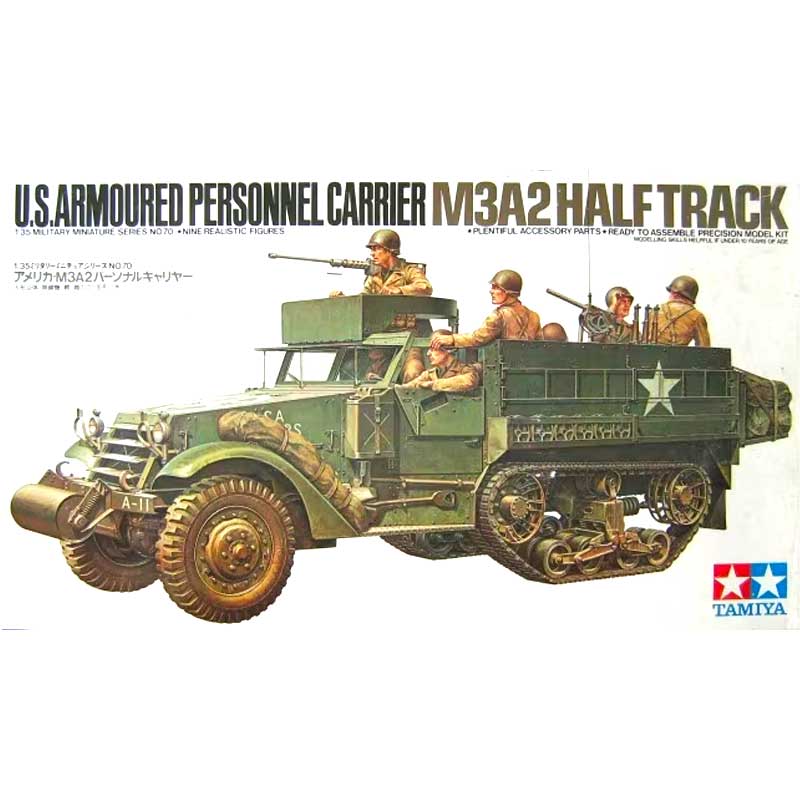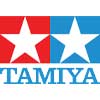The half track first appeared as a regular weapon in World War II and served as the main personnel carrier of U.S. and German armoured divisions. It adorned war history with its numerous variations and characteristic designs. As an accompanying vehicle of the tank, it showed its mobility to the full.
There were big differences as follows between the U.S. and German half tracks. In the U.S. half track, engine power was transmitted also to the front axle and steering was made only through the front wheels. In the German half track, the front wheels had no brake, and the vehicle controlled the direction of travel by changing the angle of the front wheels or by fractionally idling the sprocket wheel on one side through the link according as steering angle was under or over 15 degrees. These differences arose because the Americans originally made their half track by replacing the rear wheels of a truck by tracks, while the Germans originally made theirs by adding wheels to the front of a full-track vehicle in order to make its body longer. The Americans designed their half track as an armoured fighting vehicle from the beginning. On the other hand, the Germans used the very same chassis both for their non-armoured vehicle and armoured disadvantage. Although it showed desired performance on European roads, its mobility was much limited in the field, particularly in muddy places, because the front wheels were not driven and the engine did not offer sufficient power.
It had been known since World War ! that the tractive force of a truck with two rear axles would remarkably increase if tracks were fastened round its rear wheels. A number of nations had continue their own efforts to study and develop the half track, rear suspension for the tracks being the main object of their study. Under these circumstances, a Citroen-Kegresse half-track vehicle succeeded in running across the Sahara Dessert, which renewed their enthusiasm for developing the half track.
In the United States, the Ordnance Bureau of the Department of the Army started earnest study and development of the half track in 1925 when it purchased two Citroen-Kegresse vehicles from France. The P17 half-track tractor purchased from France in 1931 had a very great influence on the American designs and ideas of the half track. The first U.S. military half track was the T1 experimental half-track reconnaissance car made in December 1932 by Jos. Cunninghams, Son & Co., of Rochester, New York which was then developing the T1 experimental light tank. The new half-track vehicle has an open-top body and an improved version of Citroen-Kegresse running gear.
By 1937, non-armoured half tracks, T1 – T9E1, for reconnaissance, hauling weapons, carrying personnel and transporting material were trial-manufactured by Cunningham, Linn, GMC and Marmon-Herrington. These were intended to be used mainly by mechanised cavalry and artillery.
The half tracks T9-T9E1 trial manufactured by Marmon-Herrington were based on the chassis of the Ford 1 1/2 ton 4 x 2 truck of model 1936 and combined front drive with rear-bogie tracks. These half tracks had kegresse type bodies which were full of faults. In the meanshile, Marmon-Herrington, and one other manufacturer jointly developed suspension for rubber tracks of one-piece belt type devised by B.F. Goodrich. The suspension achieved very good results in tests and was adopted by the Department of Defense. It later became the basic suspension of the M2 and M3 half track series and further the standard equipment of all U.S. half tracks.
Realizing that the German mobile troops for the blitzkrieg tactics at the beginning of World War II mainly consisted of full and half-track vehicles, the Americans, who already had the suspension with high productivity, started, manufacturing half tracks in large quantities. There were a great variety of American half tracks. Their basic types mass-produced and actively used were as follows:
Half Track M2:
The first production half track officially adopted by the U.S. Army. In 1939, an experimental vehicle named “T14 Half Track APC” was made by Diamond T. Motor on the basis of the body of a wheeled armoured car which was vehing used by armoured cavalry. In September 1940 to 1943, Autocar manufactured 2,992 and White Motor Company 8,423, which made a total of 11,415.
Half track M2A1:
A modified version of the Half Track M2. On the upper right of the driver seat, it carried a ring mount M45 (often called “Pulpit”) for a 0.50-inch (12.7 mm) Browning heavy-barrelled machine gun M2. From October 1943 to March 1944, a total of 1,643 were manufactured.
Half Track M3:
This was intended to carry personnel and material of various units in armoured divisions. Autocar and Diamond T. Motor Car Company produced a total of 12,499 in parallel with the Half Track M2. Both the M3 and M2 were supplied to the Allies including the Soviet Union and Britain as well as to the U.S. Army.
Half Track M3A1:
A modified version of the M3. Like the M2A1, it carried an anti-aircraft ring mount M45 (for a 0.50-inch Browning) on the upper right of the driver seat. From October 1943 to March 1944, a total of 2,862 were manufactured by White, Autocar and Diamond T. Like the M3, the M3A1 was used in World War II by units in U.S. armoured divisions as an armoured command car, armoured ambulance car, armoured radio car, and armoured general purpose car. The M2A1 was also used by British armoured troops. Avariation with a recovery jib on the front was also used by the British as an armoured recovery car.
The M3A2:
The final production version of the M3. This was an M3-based “general purpose car” intended to be used in place of the existing M2, M2A1, M3, and M3A1. In July, 1943, a prototype named “T29” was completed and, in October 1943, accepted for production as the Half Track M3A2. This was a much polished vehicle. From 1944 on, the M3A2 saw active service as the main vehicle of armoured infantry in armoured divisions. The M3A2, like the M2 and M3 series, was a light armoured fighting vehicle with open-top body, to which hard-faced armour plates were welded or bolted. Armour was 6.25 – 12.7 mm in thickness, the nose of the vehicle being protected with relatively thick steel plate. The M3A2 accommodated 5 – 12 men i.e. one fully equipped platoon.
The M3A2 carried the standard weapons consisting of an anti-aircraft 0.50-inch Browning heavy-barrelled machine gun M2, 0.30-inch Browning machine gun M1919A4, 2.36-inch rocket launcher (bazooka) M9 or M9A1, 0.45-inch submachine gun M3, twelve 0.30-inch rifles and twelve Garand rifles. In stowage boxes inside the vehicle, the following ammunition was carried: 330 rounds of 0.50-inch machine-gun ammunition, 2,000 rounds of 0.30 inch machine-gun ammunition, 6 A/T rockets M6, 24 mines M1, 48 hand grenades and 180 rounds of 0.45 inch machine-gun ammunition. When necessary, additional machine-gun ammunition(600 rounds for the 0.50-inch Browning and 6,000 rounds for the 0.30 inch Browning) was carried in place of two seats.
The M3A2, like the M2 and M3 series, had a White 160 Ax, 4-cycle, series 6-cylinder, water cooled, gasoline engine offering 143 hp/3,000 rpm. Engine power was transmitted through the dry-type single-plate clutch, constant mesh transmission with 4 forward and 1 reverse speeds, 2-speed transfer case and banjo-type rear axle to the sprocket wheels. The vehicle used all-wheel drive system in which the front axle of the split type received power from the transfer case if necessary. The vehicle carried 227 litres of fuel and fuel consumption ratio was 1.49 km/l. Maximum cruising range was 320 km and maximum speed on good road reached 72 km/h.
Front suspension was the same in construction as that of a usual car. Rear suspension had the following construction: Two rows of four road wheels – each wheel had a rubber tyre, 305 mm in diameter and 105 mm in width, which was peculiar to American half tracks – were connected through links to the bogie assembly equipped with vertical volute springs. The belt-type rubber track was supported by top rollers at the top of the bogie assembly and by the idler wheel serving as rear body support. The sprocket wheel engaged with guides in the centre of the track to drive it.
From May 1941 to 1945, the United States produced as many as 45,044 half tracks including the officially designated versions and experimental versions of self-propelled mortars, self-propelled cannons, self-propelled howitzers, self propelled multi-barrelled guns, etc. as well as the M2 and M3 series. This total was made up as follows: 37,164 personnel carriers and 7,880 self-propelled guns. These vehicles were used in all theatres of war by 16 armoured divisions, independent mechanized cavalry groups, independent armoured groups and some units in infantry divisions.
In the case of the M3A2, 448 vehicles were used per armoured division at the approximate rate as follows: 72 to each of the three armoured infantry battalions; 20 to each of the three rifle companies; 11 to the headquarters; 11 to the headquarters company; and 1 to the service company. Details of vehicle allotment tot he rifle companies in the armoured infantry battalion of the armoured division in 1944 are tabulated as follows:
The rifle squad vehicle accommodated the driver and nine squad members consisting of one squad leader, one assistant squad leader, five riflemen, one automatic rifleman and one ammunition carrier. The platoons leaders vehicle carried 12 men including the platoon leader and his sergeant. The mortar squad vehicle accommodated eight men consisting of one squad leader, two gunners, two ammunition carriers, two riflemen and one driver. The anti-tank squad vehicle carried seven men consisting of one squad leader, two gunners, two ammunition carriers, one riflemen and one driver.
From the Korean War on, the United States gradually replaced their half tracks with fulltrack M113 series vehicles. Today, about 30 years after the end of World War II, armies of many countries including the Self Défense Forces of Japan are still using half tracks as fighting vehicles. We often receive the news that these half tracks were running about in the Mideastern war, Vietnam War and riots in South America. In the United States, however, these vehicles are merely kept in museums or by enthusiasts.



